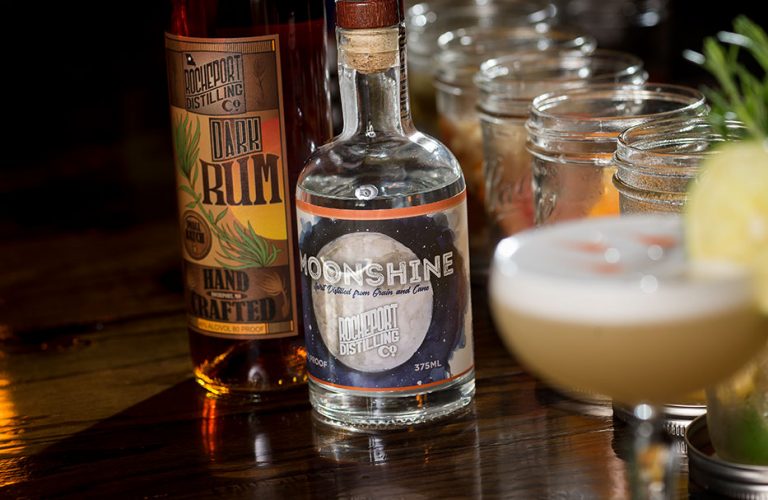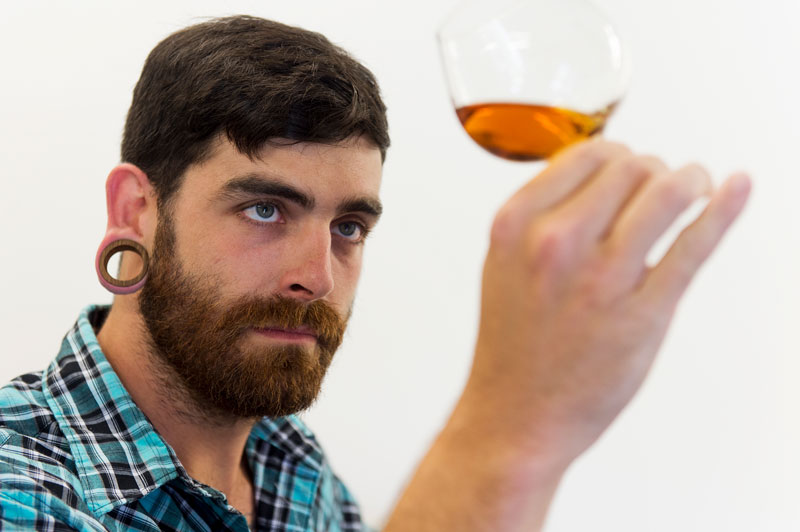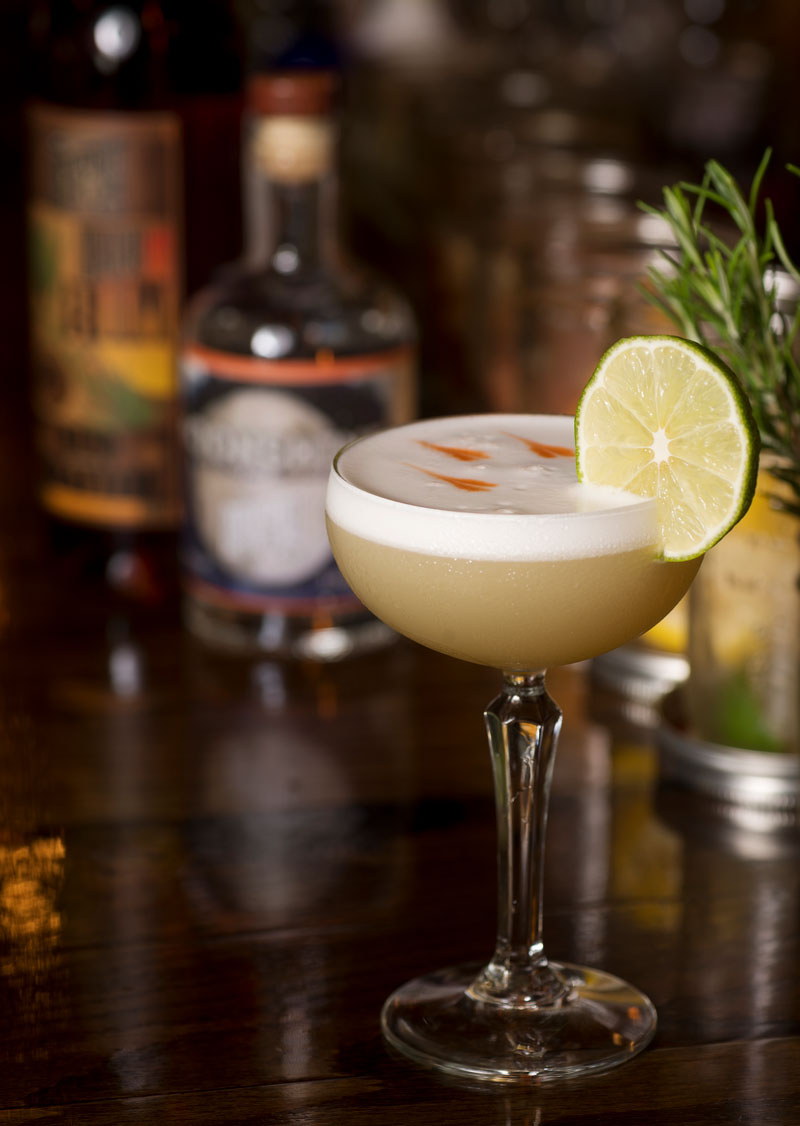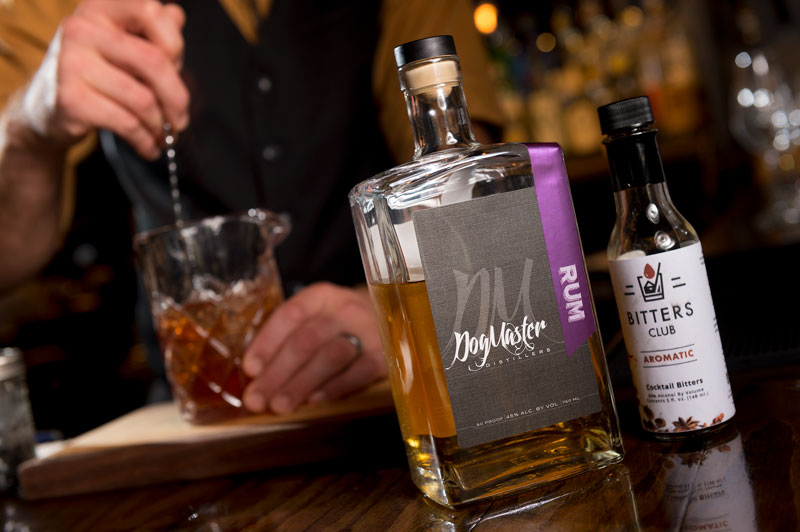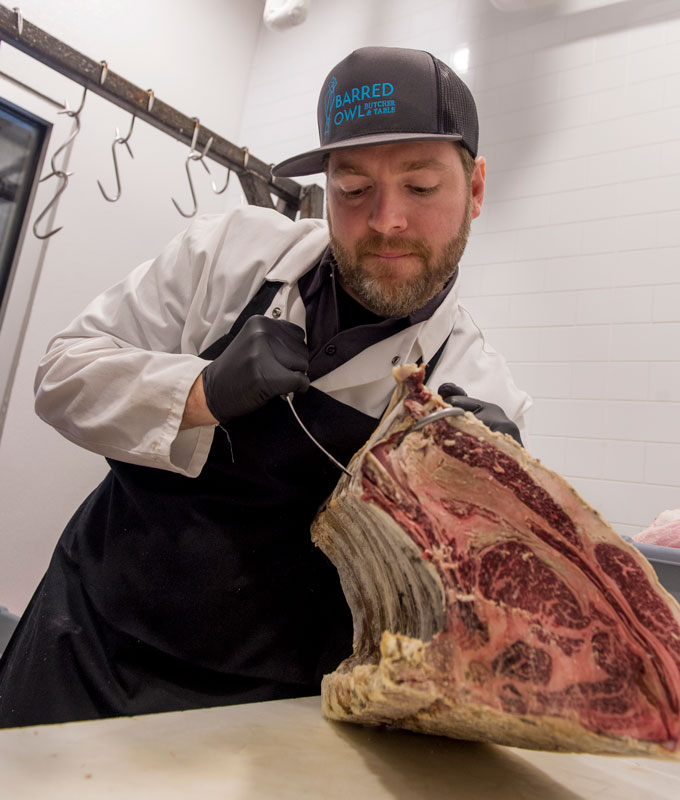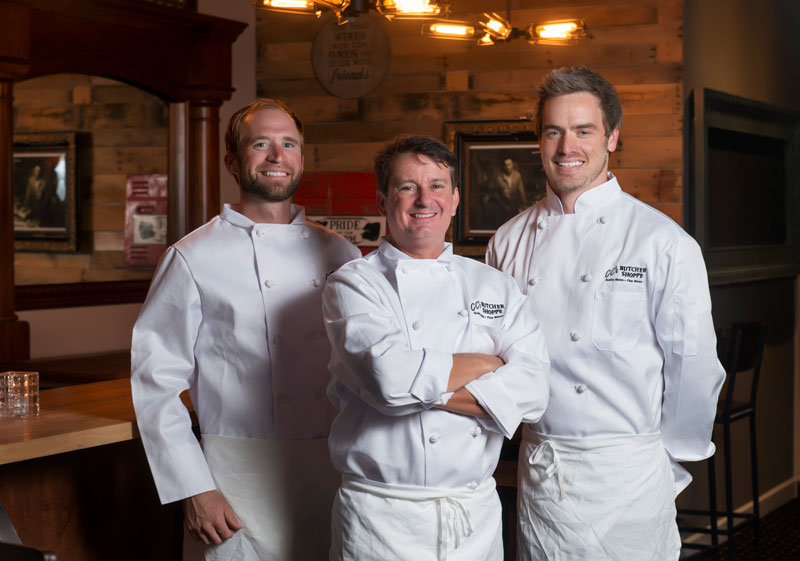Time. It’s an elusive resource most of us can’t seem to catch enough of. And what’s even more elusive than time? Patience — a virtue seemingly lost in the hustle and bustle of modern life. We move from one thing to the next in a heartbeat, our focus often split between two screens. We want our food ready yesterday. Modern humans, it’s said, have an average attention span of less than nine seconds. That’s less than a goldfish. Yikes.
Yet for these Columbia craftsmen, time and patience are the essence of their craft. These men are dedicated to producing a quality product, pouring weeks and months into aging steaks, hams and spirits to perfection, all to produce a crop of fare and drink whose only goal is to please the palate, no matter how long it takes. Let’s meet your makers.
Rocheport Distilling Co.
The Makers: Distiller Gary Paxton and Winemaker Jacob Holman
Gary Paxton and Jacob Holman spend their days immersed in the art of transformation. When Holman isn’t busy turning Les Bourgeois grapes into Missouri wine, he’s helping distiller Gary Paxton with Rocheport Distilling Co., the winery’s next-door neighbor.
It’s this “spirit” of collaboration that makes Rocheport Distilling Co. work. Tucked away in the back of the tasting room, the distillery finds itself in the heart of mid-Missouri wine country. And that definitely has an impact on what’s being produced. Gary Paxton, a member of the Les Bourgeois winery team since 2009, officially took over distilling operations in the summer of 2016.
When Rocheport Distilling Co. ran its first batch through the still a few years prior, there was a different distiller at the helm. He steered the spirits on a tropical course, pumping out batches of Caribbean-style rum.
“The original distiller was really focused on rum, so we did a lot of sugar cane and molasses in the beginning, but now that he’s moved on we’re going to focus on fruit stuff,” Holman says. “It’s a really natural thing for us. We are fermenting fruits making wine, and making different varieties of brandy.”
Even after hopping over to the spirits side of the fence, Paxton still works closely with Les Bourgeois winemaker Jacob Holman, sharing ideas, equipment and even grapes.
“We’ve worked together for so long that it just made sense,” Paxton says. It did make sense, for the distilling, too. The tanks in the winery provide a place for booze to begin its journey to the dark — or light — side. “We’ve always collaborated; I do most of the fermentations, then I turn it over to the distillery where he can work his magic.”
Using both outlets to craft distillates makes this operation stand out amongst the handful of mid-Missouri producers.
“That’s one of the coolest parts about being a winemaker, is that it gives us the freedom on what we can experiment with,” Holman says. “Before, I probably wouldn’t have tried to make a peach wine, because what if it turned out bad? Then you’ve lost all this money, but with the distillery there, we can run a whole different range of products. It’s kind of exciting.”
The pair will try to replicate time-tested traditions used in foreign distilleries to create local products such as brandy. “The idea was that places where brandy was invented, they were basically picking green grapes that weren’t ripe and using them, making wine and using it for brandy because they weren’t fit to be wine,” Holman says. “So in order to kind of re-create that, we pick grapes a little greener, even though they would ripen, we pick them for the brandy track, to kind of simulate cool growing conditions in France.”
Though the traditions are borrowed from faraway lands, these products will taste local and they’ll be timely, too. Focused around the 2017 eclipse, the distillery brought out moonshine for the event, serving lunar-inspired cocktails to guests who arrived to watch the eclipse at the A-frame. Also in the lineup for production are brandy, whiskey, rum and eventually, gin.
The aforementioned spirit of collaboration promises for some special bottles of spirits, Paxton says. “We have so many connections with people who want to be involved with it and give their fruit up for that. We’re building on some pretty cool relationships.”
But those special projects, likely made in small quantities, might not be on store shelves. You’ll have to head out to Rocheport to try them. “We see the tasting room being a good place to showcase some of the small batches, because a lot of that probably isn’t going to go to market,” Holman says. “The peach brandy we probably had only 100 gallons of, and by the time you fill the store shelves you run out of product. We see it being a place to pour here, and for customers to kind of experience what we’re doing in the back.”
•••••••••••••••••••••••••••••••••••••••••••••••••••••••••••••••••••••••••••••••••••••••••••••••••••••••••••••••••••
Meet Your Maker Cocktails Cocktail creations from Barred Owl’s Andrew Ruth
Moon County, MO
1 1⁄2 ounces Rocheport Distilling Co. moonshine
1⁄2 ounce Rocheport Distilling Co. aged rum
1⁄2 ounce fresh lemon juice
1⁄2 ounce fresh lime juice
3⁄4 ounce local honey syrup (1:1)
1 egg white
Pour all ingredients into a cocktail shaker. Seal and shake without ice for about 10 seconds to start the egg white whipping. Add ice, and shake vigorously for about 20 seconds. Double strain into a coupe cocktail glass. Garnish with a lime wheel and a few drops of Angostura bitters… cheers!
Andrew’s Notes:
Tasting the moonshine for the first time reminded me of Pisco with super tropical notes so I immediately thought about playing on a Pisco Sour and kind of crossing it with a daiquiri. I added the aged rum for some barrel character and a hint of sweetness and subbed out some beautiful local honey syrup for the sweetener. The egg white adds texture, body and foam to the cocktail and really sets off the appearance. This is a beautiful cocktail and the local spirits and honey really set it apart.
•••••••••••••••••••••••••••••••••••••••••••••••••••••••••••••••••••••••••••••••••••••••••••••••••••••••••••••••••••
DogMaster Distillery
The Maker: Co-owner and distiller Dan Batliner
The owners of Columbia’s lone downtown distillery don’t often follow the beaten path. Such a mind set was the inspiration for its name, DogMaster. The owners define the word DogMaster as:
• A person who does their own thing.
• One who doesn’t settle for the status quo.
• Someone who enjoys the “finer” things in life, and won’t let others define “finer” things for them.
• An individual who blazes their own path and proudly marches to the drumbeat they create.
Dan Batliner is a DogMaster. And that’s why he fits right in distilling whiskeys, rums and bourbon for the company, of which he’s co-owner. Batliner began distilling at DogMaster in August 2016, after being a silent partner in the business for more than a year.
With an education in chemical engineering, he considers the distillery his playground, and distilling is his favorite game. “It’s a fusion of science and nature,” Batliner says. “The enzymes turning starch into sugar is a natural process. Turning sugar into alcohol is a natural process. We get to apply some science to these natural things and nurture them along in the right environment, and make a product that people enjoy.”
It’s safe to say that within each barrel inside DogMaster, is a new drum with which Dan creates a beat all its own. That’s the goal, and the excitement of small batch distilling, says co-owner Van Hawxby. Though science can be exact, it’s the art that creates the mystery that is the taste of each unique barrel. “I think there’s a little bit of romance in not knowing,” he says.
The distillery and bar lies on the edge of the North Village Arts District, refining spiritual arts such as rum, whiskey, bourbon and soon, gin. The owners, Van and Lisa Hawxby, along with Dan and Stephanie Batliner, have been passionate about distilling for years, and were finally able to turn the hobby into a career 3 years ago with the opening of their small business.
The longtime friends find that it’s a balance of consistency, adventure and, most importantly, fun, that keeps the still running. Van ran the production show until last August, but Batlier took over the distilling operations, commuting from his home in St. Joseph, Missouri, a few days each week, so that Van and Lisa could focus more on the sales and marketing aspect of the business.
The job of creating a product from scratch was a perfect fit for Dan, who is enchanted by taking ideas and turning them into something tangible. “I’m always building something,” he says. “I just enjoy creating things. And that’s what this is; we’re creating something.”
Those creations stem from all local ingredients, with the exception of barley, a cold-climate crop. “It all comes from right here in Boone County,” Hawxby says. “We get our grains from the local MFA station, so we know that it’s more than likely grown within a 50 mile radius of Columbia.”
Down the road, DogMaster hopes to whittle that locality down even further, to an individual site. “We hope to get to the point where we can contract with a local farmer, or local grower, to grow the type of grain that we want, and have the amount of grain that we want,” he says. “We’re just not at that point yet. And if we were able to do that, that would just add to our story.”
•••••••••••••••••••••••••••••••••••••••••••••••••••••••••••••••••••••••••••••••••••••••••••••••••••••••••••••••••••
Old St. James
2 ounces DogMaster aged rum
1/2 ounce Benedictine
1/2 ounce sweet vermouth
1/4 ounce Campari
2 dashes Bitters Club aromatic bitters
Pour all ingredients into a mixing glass. Add ice and stir for about 20 to 25 seconds. Strain into a chilled cocktail glass or Nick and Nora glass. Garnish with a high quality cherry.
Andrew’s Notes:
I love DogMaster’s Rum and wanted to play off the rich barrel complexity and the alcohol by doing a strong, stirred cocktail reminiscent of a Manhattan or Vieux Carre. The Campari adds some bitterness and the Benedictine adds a honey and herbal component that I absolutely love (Benedictine pretty much goes with all barrel aged spirits). The Bitters Club is a local bitters company and has some great products that can be a perfect accent to add depth to a cocktail and can be used to substitute for angostura bitters. Support local!
•••••••••••••••••••••••••••••••••••••••••••••••••••••••••••••••••••••••••••••••••••••••••••••••••••••••••••••••••••
Barred Owl Butcher Shop
The Maker: Co-owner Joshua Smith
In 2006, Joshua Smith was on the hunt for guanciale. But the Italian cured meat, made from hog jowl, wasn’t hiding out in any stores or restaurants. So, he made it himself. Eleven years later, he’s working on making cured meats, along with other specialty cuts, available for those in search of them as he once was, as co-owner and butcher of Barred Owl Butcher and Table.
Though the restaurant brings a fresh menu to the dining room every single day, the methods to their madness take root in a much older and time-tested philosophical soil. The culinary team embraces a “whole animal” approach. Simply put, they don’t like waste. From fried headcheese to more traditional cuts like sirloin and strip, almost every part of every animal can be plated in some tasty form or fashion. This philosophy harkens back to a time when food wasn’t so steadily abundant.
“I think the notion of not being wasteful is coming back, and not just for necessity, but just as a sort of sense of responsibility for the things we’re eating,” Smith says. “We shouldn’t just treat [meat] like a commodity.”
And that’s not just from a financial standpoint,” he says. “No one wants to be throwing away money, but really it’s because there were farmers that put time into growing these things, and we put time into prepping them and it’s important to see how much you can get out of something to get the flavors that are there for you. We do that with everything.”
That traditional reverence is apparent in all cuts and cures throughout the butcher shop and in the dining room. The techniques of Spaniards and Italians who are known for creating revered delicacies such as Jamon Iberico and prosciutto di Parma are mirrored in the varying charcuterie.
“Our idea here is to respect those time-honored traditions both from Europe where we draw a lot of inspiration, but also what is regional,” Smith says. As of now, the cured meats are still made by other producers who follow these same traditions. But once licensing is approved, most of the curing will be done in-house.
Some of those regional aspects take shape as heritage breed animals that are finished off with a diet that follows the same traditions. “Ideally, at some point one of those farmers or two, come fall, are finishing the animals in the woods,” he says. “And they’re eating acorns and walnuts and hickory nuts and whatnot. And hopefully we get something similar to a Spanish Iberico ham, a bellota, which is an acorn-finished ham they do there; it’s the pinnacle of ham making in the world.”
For Smith and the rest of the staff at Barred Owl, in everything they do, it’s really about the human connection with the food. “At the heart of it it’s about the food,” he says. “It’s about feeding people, which is a pretty intimate act. Life starts by a mother feeding her child; that’s where it all begins.”
To be a part of that human experience is an honor, he says. “It’s fun because it’s nice to see the smile on someone’s face in a restaurant, or a whole table full of people having a good time eating and drinking, and knowing that in your own way, you helped make that happen.”
Follow Barred Owl Butcher and Table on social media to keep updated about new butcher shop releases.
•••••••••••••••••••••••••••••••••••••••••••••••••••••••••••••••••••••••••••••••••••••••••••••••••••••••••••••••••••
CC’s City Broiler Butcher Shop
The Maker: Scott Cleeton
One of Columbia’s finest restaurants wants to pop up shop in your backyard. That’s the goal with CC’s City Broiler’s new butcher shop, located adjacent to the restaurant on Forum Boulevard. The experience will be a new one for the clientele, who are used to dining inside the white table-clothed eatery, owned and operated since 1995 by Scott Cleeton. But the idea, Cleeton says, is far from brand new.
“I’ve had this idea, for this butcher shop, maybe 15 years ago,” he says. “We always thought that there are times, particularly in the summer or spring, that people don’t want to be cooped up inside.”
So, since his restaurant no longer offers patio dining, he had to change the venue to something a little less boutique baroque — and a little more backyard barbeque. “We thought that we’d still like to be a part of that someway, somehow, so by doing steaks that you could come in and select and take home, that would be kind of cool.”
As proprietor of CC’s, Scott has always prioritized quality over quantity. This golden rule rings true in all tenets of his restaurant, from the steaks and seafood, to the dining room and wait staff. The butcher shop will be no different.
“I think this is the perfect time for us to grow, as people continue to sharpen their interests on higher quality versus quantity,” he says. The steaks, chops and seafood showcased in the cases will no doubt highlight this philosophy.
“We’re really going to get into the higher grade cuts of beef, the higher grade aged prime beef and things that we can age and kind of control ourselves,” Cleeton says.
Though the restaurant has experienced success in having the butchering processes done by a third party for over 20 years, Cleeton wanted to take on the job, and take his career back to its roots. His father, known to friends and colleagues as “Cleet”
Cleeton was in the butchering and meat sales business in California. His father, Scott proudly says, was good at his job; once he even provided the meat for a Reagan family barbeque. Scott Cleeton followed in his father’s footsteps, unbeknownst to him becoming the third in three generations of men to make a go of the business.
“I found a picture of my grandfather cutting meat years ago,” he says. “And I didn’t know that he had ever done that. So I framed that picture and it’ll be in the butcher shop too. I didn’t know that I’d wake up one day and find the reason that I want to do this is probably because I was born into it.”
Born with an eye for quality cuts, Cleeton aims to take his already savory selection of steaks and turn the quality up yet another notch. “You’ll see that attention to the quality of the meat is for sure here, and we control it,” he says. From the individual cuts of steaks — sirloins, filets, strips, etc. — to the aging process, Cleeton will have a direct hand in it all.
“I like the fact that you can see how our aging happens;” Cleeton says. “Our big walk-in cooler is going to have great big glass windows; you can look inside and see the meat hung up; not the whole animal, but just these primal cuts that will be aging in different ways.”
In final form, steaks will be first up for sale at the shop. As time goes on, the case will bolster to include pork, seafood and more. “We’re going to concentrate on what we do very well,” Cleeton says.
However, steaks won’t have to be your only takeaway from the shop; Cleeton will be happy to suggest one of the 4,000 bottles of wine from the cooler for you to pair with your fare. And, if you do feel like hosting a party, just not in your backyard, the new shop will offer more private event space on weeknights.
In front of the counter, guests waiting for a table next door at CC’s can pop over for a glass of wine as they wait. “That’s really one of my main things is to have that additional space for events,” he says. “To have this space available on the weekends to sample wine and wait for your table is going to be very cool.”
But for those nights when home is where you really want to be, Cleeton wants to be there, too. “As close as I can possibly get to being in the backyard holding a beer with our guests, as close as I can be to putting CC’s in their backyard, that’s my goal,” he says.

